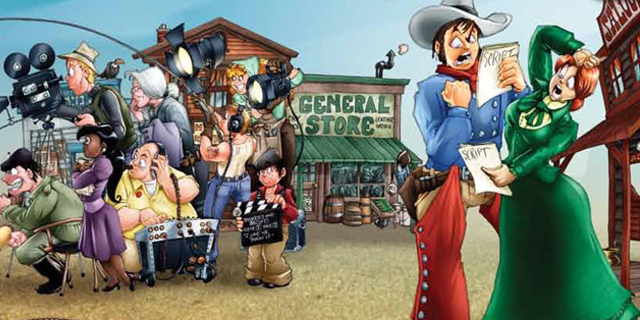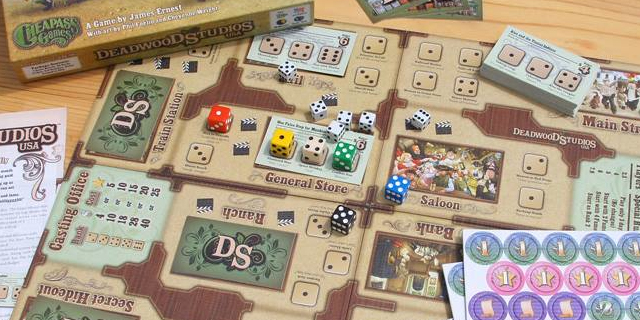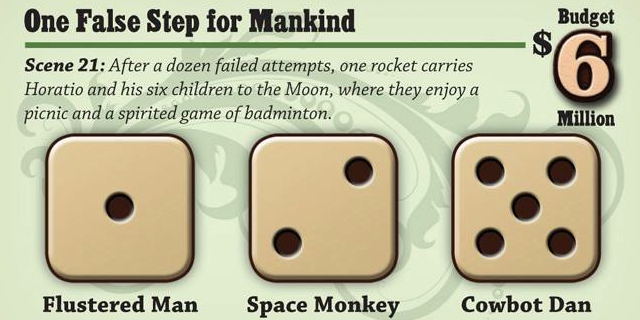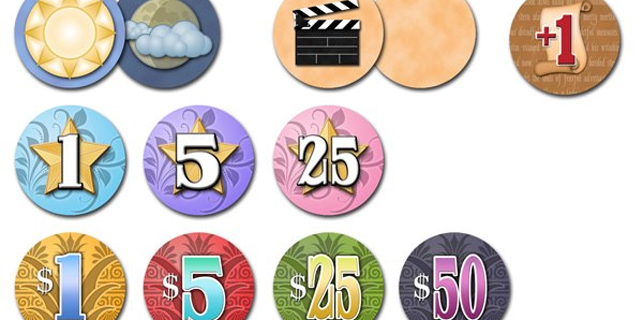
You can play Deadwood Studios, USA (originally Deadwood in its 1999 incarnation but changed in its most recent printing for a couple of reasons) for free right now by going to the Cheapass Games site and downloading the print and play edition. Or, for $40, you can get the new prettied-up (and rules-revised) Kickstarted edition and take it easy on your printer.
Your move, pardner.
Sorry. Got into character for a minute there. But that’s part of the fun of playing Deadwood Studios, USA, which pits players as B-movie spaghetti western actors filming various scenes on the Deadwood Studios back lots over a series of four days. Of course, you can’t just take any role you want. Players start out as rank-one neophytes barely suitable for the hotel scene’s “sleeping drunkard,” and must earn cash and fame to increase their stature to take on more challenging roles like “man falling off roof” or even “back end of horse.”
The back lot is comprised of ten sets, plus the Trailers and the Casting Office. At the beginning of each day, each set is dealt one scene card face-down, and all of the shot markers are turned face-up. Players begin each day in the Trailers, using a six-sided die to represent both their actor and their current rank. On their turn, a player may take one of several actions.

The first action is moving to an adjacent set (or room), revealing the scene currently being filmed there if this hasn’t already been done. You may opt to take one of the available roles if you have sufficient rank to take it. This can only be done if you aren’t currently working on a role, of course.
Once a role is taken, you may choose to either act or rehearse. Rehearsing is basically passing your turn, but each time you do so, you get a bonus on all acting rolls you take while this scene is being filmed. To act, the player rolls a six-sided die and tries to meet or exceed the number indicating the scene’s budget. It may or may not be good luck to actually act out the line provided when doing this.
The type of role being acted will determine the rewards, if any, of the acting attempt. If you are acting a role featured on the scene card itself and you fail, then you get nothing, because you sucked. Success on an on-card acting roll will earn you two fame points. As off-card roles are standard for the set (the “humble barkeep” is in every bar scene, for example) they’re essentially extras and only earn one fame for succeeding, but they also earn a dollar. Of course, they earn that same dollar even if they fail the roll, because the studio doesn’t care how they actually do as long as they show up.

Regardless of the type of role being acted, a successful roll will advance the scene by turning one of the shot markers over. When the final shot is completed, the scene is wrapped and there might be a windfall bonus. If there are any actors on the card, the player who completed the scene will roll a dice equal to the budget target number and arrange them in descending order starting with the most prestigious (highest-ranked) role, with any leftovers starting over at the highest role again until all dice are assigned. Any actors on the card then receive dollars equal to the dice assigned to their role, which can be an awesome payday. Off-card actors only earn dollars equal to their role’s rank requirement, but if there are no on-card actors when the scene wraps there is no windfall at all! The scene card is then removed and all actors involved are free to move on to a different scene and role on their next turn.
So what do you do with all of this cash and fame? If you’re in the Casting Office at the start of your turn, you can upgrade your rank as your action. The costs for each rank are listed, but it is important to know that these costs are the same regardless of your current rank. So it will cost you the same amount of fame or cash to go from rank one to rank three as it will for you to get to three from rank two. Of course, it will be hard to earn the big bucks and/or enough fame to reach the upper echelons without making a stop somewhere along the way, as most of the on-card roles demand a rank of at least two. When and how far you rank up will be a crucial strategic decision, especially as the game winds down.

The current day ends when all scenes but one have been completed. That last scene is abandoned with no windfall, so plan ahead. At the end of the fourth day, the game is over and players total up their scores. Each actor rank is worth five times its value, plus one for each fame point and/or dollar. In the unlikely event of a tie, whoever started later in the first day has the advantage, as earlier players most likely took all of the cushy low-ranked roles before they could get there.
The game supports from two to six players, so it will be a good fit for most any size group. If you have a couple of extra distinct dice, you can even play with seven or eight. The number of starting players will change the game setup in various ways involving starting fame, rank, or even number of days played. The four game boards can also be combined in just about any arrangement you desire for extra variety from session to session.
As with most Cheapass Games, the fun of playing Deadwood Studios, USA lies in… well, having fun with it. These aren’t strategic brain-burners by any stretch of the imagination, although there are definitely important choices to make like when to rehearse, what roles to take, and the upgrade options I mentioned. But if you aren’t reading the often-hilarious scene descriptions, giving a dramatic line reading as you make your acting roll, and maybe even making up excuses for why your roll failed you are probably not going to enjoy this game as it’s mechanically just a bunch of boring dice rolls and risk-versus-reward assessment. So ham it up a little!



















